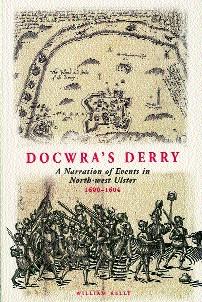Docwra’s Derry: a narration of events in north-west Ulster 1600–1604
Published in Book Reviews, Early Modern History (1500–1700), Issue 2 (Mar/Apr 2005), Reviews, Volume 13 Docwra’s Derry: a narration of events in north-west Ulster 1600–1604
Docwra’s Derry: a narration of events in north-west Ulster 1600–1604
William Kelly (ed.), edited in 1849 by John O’Donovan
(Ulster Historical Foundation, £6.99)
ISBN 1903688221
On 9 October 2003 this edition of Sir Henry Docwra’s tract was given a notable launch in the Tower Museum in Derry City. In the generous spirit of a shared history and heritage, the City Council and The Honourable The Irish Society commissioned and supported the production of this new edition of a hitherto comparatively inaccessible early seventeenth-century text, A narration of the services done by the army ymployed to Lough-Foyle under the leadinge of mee Sir Henry Docwra Knight, Charles Lord Mountjoy being then lord deputie afterwards Earle of Devonshire and Lord Lewetenant of Ireland together with . . .
The work was penned by Docwra in self-imposed early retirement at his manor of Bradfield in Berkshire in the summer of 1614. The manuscript went with his household effects to Dublin on his appointment as treasurer-at-war in 1616 and lay there until its discovery in the Ordnance Survey Office in 1849 by that celebrated scholar John O’Donovan, the ‘Fifth Master’, the translator and editor of the Annals of the Four Masters. The manuscript flyleaf is inscribed Theo Docwra, Sir Henry’s eldest son. He did not long survive his father’s death in 1631, and the title Baron Culmore (the place-name commemorating the first landing of Sir Henry and his soldiers at the Foyle estuary) became extinct.
O’Donovan’s edition of the Narration was published in the first volume of the Ulster Archaeological Journal in 1849, and though well-enough known to a small coterie of historians working on sixteenth-century Ireland it was not deemed sufficiently important as a source to compete with the better-known writings of Mountjoy, Carew and Chichester. Neither, until fairly recently, was its author thought to be that important in the prosecution of the Nine Years’ War. Docwra could also claim to be the early modern founder of the city of Derry since he was instrumental in paving the way for its first royal charter elevating its status from town to city, granted and enrolled in July 1604, which acted as the curtain-raiser for King James I’s plantation of Ulster. As every schoolboy and girl should know, St Columcille, an Ó Domnhaill, was Derry’s first founder, in the sixth century. A millennium later, instead of a monastic-based settlement Derry became the headquarters of a military garrison that would spawn other garrisons along the Foyle up to Omagh on the Strule and along the Erne to Beleek and Ballyshannon.
The overall commander of these operations and cautious strategist was Henry Docwra, who had plenty of experience as a professional soldier in the Netherlands and France but particularly in Connacht under the notoriously cruel governor Sir Richard Bingham. Along with the Narration Docwra wrote an account of Bingham’s military operations, known as The relation, included in O’Donovan’s edition but not here. However, the omission is more than compensated for by Kelly’s scholarly 30-page introduction and the retention of O’Donovan’s original and valuable topographical and genealogical notes. Both maintain Docwra’s crude punctuation, eccentric capitalisation and characteristically verbose style. Provost J.P. Mahaffy of Trinity College found it easier to transcribe in full his official correspondence, scattered throughout the Irish state papers from 1600 to 1603, than abstract them for the calendars, complaining as he worked of Docwra’s ‘magniloquence’. Docwra tells us how he came to write the Narration as his justification for his actions in Derry and north-west Ulster. He was his own apologist. And, from the history student’s viewpoint, he gives us an interesting insight into his historical working methods when he says:
‘I had lying by mee some memoriall noates and a great Nomber of letters that yf they were well searched over toagher with the helpe of myne owne memorie were able to bring to light the truth of that which otherwise was lyke to perish and Consume in Darkness. I spent no little tyme to peruse them and these are the effects the doings thereof hath produced.’
His Narration in this much more accessible edition is highly recommended for insights into the actualities of the Elizabethan soldier’s life in north-west Ulster in the closing stages of the Nine Years’ War, and for the way in which Docwra’s Irish allies, Niall Garve O’Donnell, Donal O’Cahan and Cahir O’Dogherty, were so disgracefully treated at the end of the war, Docwra being unable to fulfil the promises he had made them. His own and their disillusionment, along with Mountjoy’s and later Bishop Montgomery’s hostility, were the main causes why he departed from the city he had begun to establish.
Although Docwra was appointed governor-for-life with a good pension, he was disappointed in his further ambitions. At one stage he set his sights on a presidency for Ulster, in imitation of the Munster presidency.
Kelly’s edition, with its contemporary maps and modern military campaign maps, chronology and most helpful glossary for those unfamiliar with the Gaelic spelling of Irish surnames, must be welcomed by all serious students of this crucially significant chapter in Irish history. St Columba or Columcille and Sir Henry Docwra are unlikely bedfellows as key founders of Derry and actors in its turbulent past. While both departed from Derry in widely differing circumstances, their impact has never been forgotten. And, as Dr Kelly puts it, ‘after Docwra, the English stayed’.
John McGurk
















